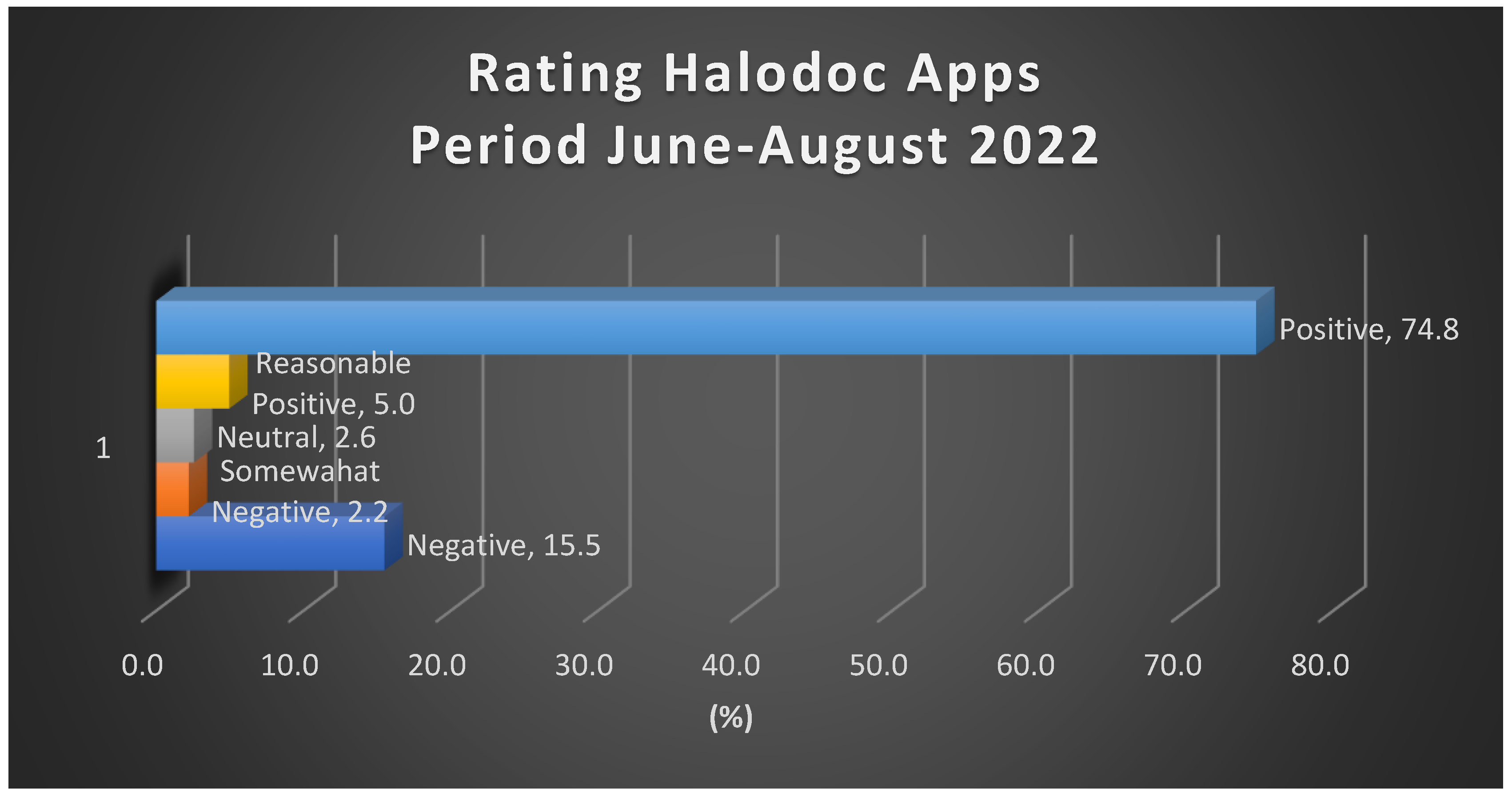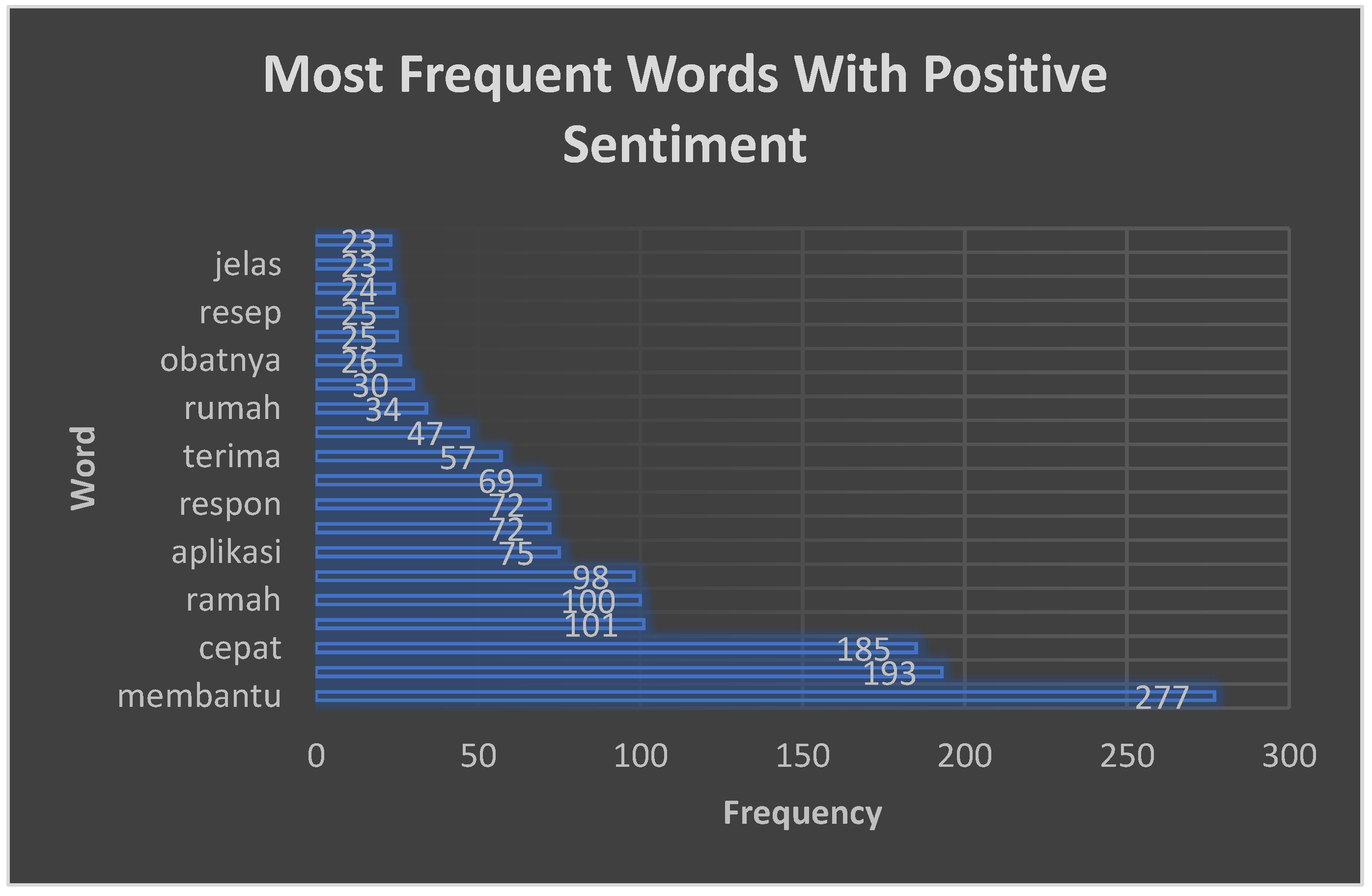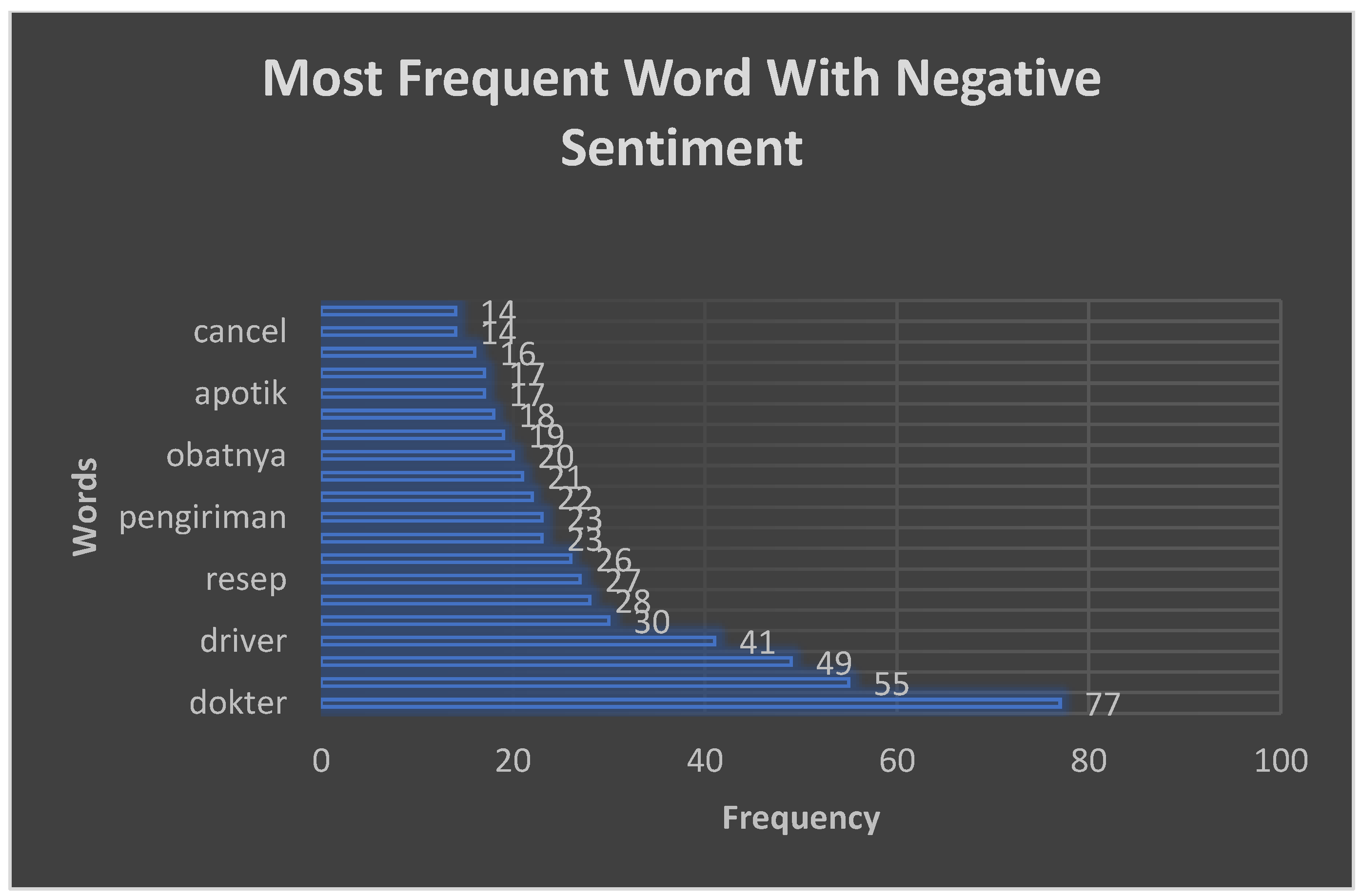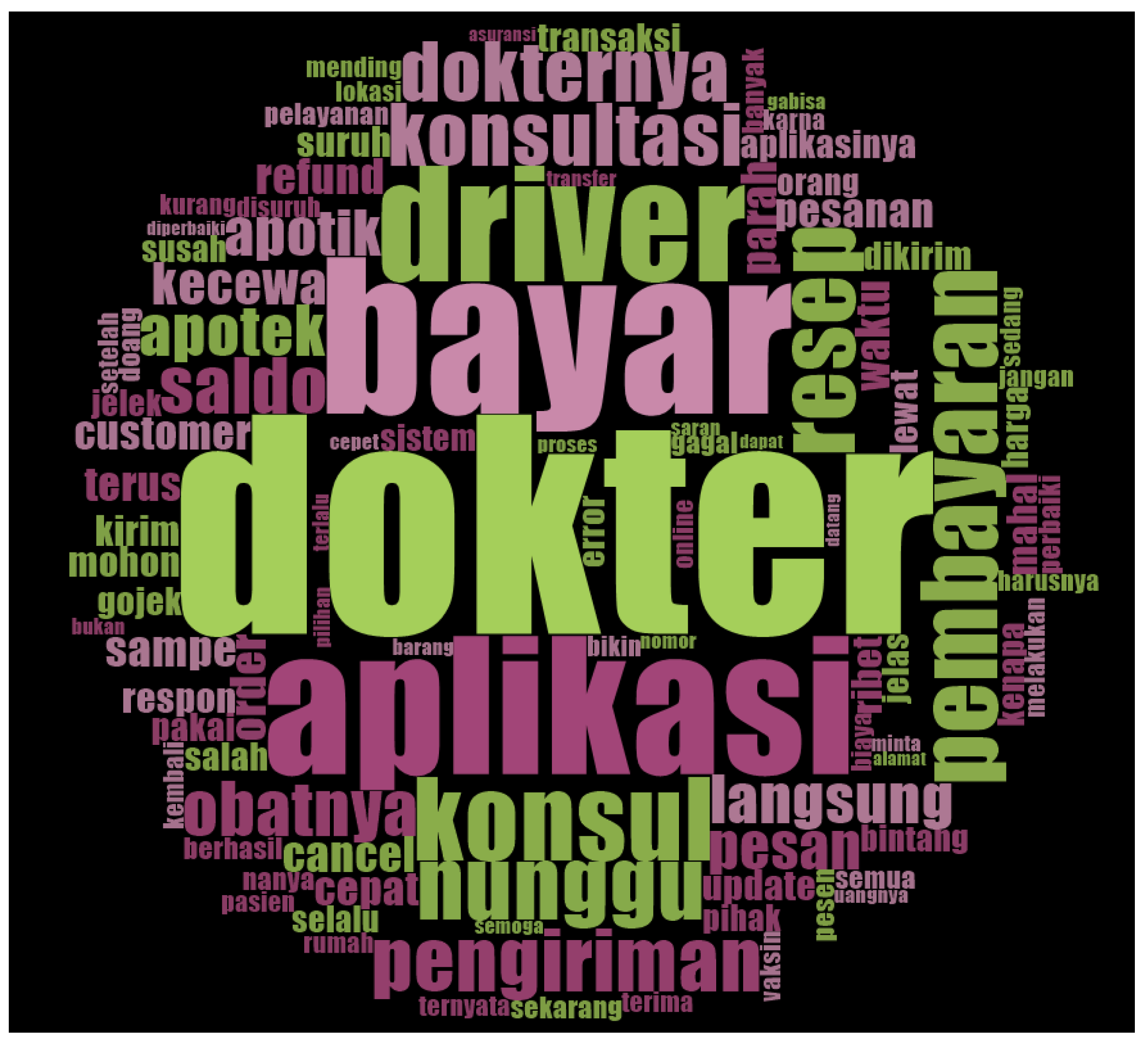Sentiment Analysis Telemedicine Apps Reviews Using NVIVO †
Abstract
1. Introduction
2. Material and Methods
3. Results and Discussion
3.1. Quantitative Phase
3.2. Qualitative Phase
4. Conclusions
Funding
Institutional Review Board Statement
Informed Consent Statement
Data Availability Statement
Conflicts of Interest
References
- Biswas, M.; Tania, M.H.; Kaiser, M.S.; Kabir, R.; Mahmud, M.; Kemal, A.A. ACCU3RATE: A mobile health application rating scale based on user reviews. PLoS ONE 2021, 16, e0258050. [Google Scholar] [CrossRef] [PubMed]
- Fakhruzzaman, M.N.; Palupi, G.S.; Rochmah, T.N. Fear of missing out during a pandemic: The driving factors of telemedicine application acceptance. Bull. Electr. Eng. Inform. 2022, 11, 2331–2338. [Google Scholar] [CrossRef]
- Muhammad, H.; Fajari, F.; Rozi, M.F.; Gumay, L.A.; Shihab, M.R.; Azzahro, F. Enabling Self-diagnosis Using Trusted Online Healthcare Platform: A Case Study from Alodokter. In Proceedings of the 2019 International Conference on Information Management and Technology (ICIMTech), Jakarta/Bali, Indonesia, 19–20 August 2019; pp. 592–595. [Google Scholar] [CrossRef]
- Afifah, K.; Yulita, I.N.; Sarathan, I. Sentiment Analysis on Telemedicine App Reviews using XGBoost Classifier. In Proceedings of the 2021 International Conference on Artificial Intelligence and Big Data Analytics, Bandung, Indonesia, 27–29 October 2021; pp. 22–27. [Google Scholar] [CrossRef]
- Mangkunegara, C.N.; Azzahro, F.; Handayani, P.W. Analysis of factors affecting user’s intention in using mobile health application: A case study of halodoc. In Proceedings of the 2018 International Conference on Advanced Computer Science and Information Systems (ICACSIS), Yogyakarta, Indonesia, 27–28 October 2018; pp. 87–92. [Google Scholar] [CrossRef]
- Zhai, Y.; Song, X.; Chen, Y.; Lu, W. A Study of Mobile Medical App User Satisfaction Incorporating Theme Analysis and Review Sentiment Tendencies. Int. J. Environ. Res. Public Health 2022, 19, 7466. [Google Scholar] [CrossRef] [PubMed]
- Santos, A.I.G.P.; Perinotto, A.R.C.; Soares, J.R.R.; Mondo, T.S.; Cembranel, P. Expressing the Experience: An Analysis of Airbnb Customer Sentiments. Tour. Hosp. 2022, 3, 685–705. [Google Scholar] [CrossRef]
- Meyer, J.; Okuboyejo, S. User Reviews of Depression App Features: Sentiment Analysis. JMIR Form. Res. 2021, 5, e17062. [Google Scholar] [CrossRef] [PubMed]
- Saura, J.R.; Palos-Sanchez, P.; Grilo, A. Detecting indicators for startup business success: Sentiment analysis using text data mining. Sustainability 2019, 11, 917. [Google Scholar] [CrossRef]
- Elliott, J. The Craft of Using NVivo12 to Analyze Open-Ended Questions: An Approach to Mixed Methods Analysis. Qual. Rep. 2022, 27, 1673–1687. [Google Scholar] [CrossRef]
- Tarmidi, D.; Mardhatillah, S.; Masripah, F.; Febriyanto, D.; Pribadi, T.A. The Influence of Product Innovation and Price on Customer Satisfaction in Halodoc Health Application Services During COVID-19 (Survey of Halodoc App Users in Bandung in 2021). Turk. J. Comput. Math. Educ. 2021, 12, 1084–1091. [Google Scholar]
- Hudson, G.; Negbenose, E.; Neary, M.; Jansli, S.M.; Schueller, S.M.; Wykes, T.; Jilka, S. Comparing Professional and Consumer Ratings of Mental Health Apps: Mixed Methods Study. JMIR Form. Res. 2022, 6, e39813. [Google Scholar] [CrossRef] [PubMed]
- Roland, M. General practice by smartphone. BMJ 2019, 366, 2–4. [Google Scholar] [CrossRef] [PubMed]
- Mitgang, E.A.; Blaya, J.A.; Chopra, M. Digital Health in Response to COVID-19 in Low- and Middle-income Countries: Opportunities and Challenges. Glob. Policy 2021, 12, 107–109. [Google Scholar] [CrossRef] [PubMed]
- Nurhudatiana, A.; Seo, J.Y. An mHealth Application Redesign based on Nielsen’s Usability Heuristics: A Case Study of Halodoc. In Proceedings of the 6th International Conference on E-Business and Applications (ICEBA 2020), Kuala Lumpur, Malaysia, 25–27 February 2020; pp. 85–89. [Google Scholar] [CrossRef]
- Silalahi, R.V.; Hartono, N.; Tumpak, M.A. Profile and preferences users of doctors consultation application in Indonesia. IOP Conf. Ser. Earth Environ. Sci. 2018, 195, 1–11. [Google Scholar] [CrossRef]





| Category Rating | Frequency | Percentage (%) |
|---|---|---|
| Negative | 175 | 15.5 |
| Somewhat negative | 25 | 2.2 |
| Neutral | 29 | 2.6 |
| Reasonably Positive | 56 | 5.0 |
| Positive | 844 | 74.8 |
| Total | 1129 | 100 |
| Category | Total | Percentage (%) |
|---|---|---|
| Service | 593 | 52.48 |
| System | 333 | 29.50 |
| Payment | 174 | 15.37 |
| Place | 30 | 2.64 |
| Total | 1129 | 100 |
Disclaimer/Publisher’s Note: The statements, opinions and data contained in all publications are solely those of the individual author(s) and contributor(s) and not of MDPI and/or the editor(s). MDPI and/or the editor(s) disclaim responsibility for any injury to people or property resulting from any ideas, methods, instructions or products referred to in the content. |
© 2022 by the author. Licensee MDPI, Basel, Switzerland. This article is an open access article distributed under the terms and conditions of the Creative Commons Attribution (CC BY) license (https://creativecommons.org/licenses/by/4.0/).
Share and Cite
Nurfikri, A. Sentiment Analysis Telemedicine Apps Reviews Using NVIVO. Proceedings 2022, 83, 4. https://doi.org/10.3390/proceedings2022083004
Nurfikri A. Sentiment Analysis Telemedicine Apps Reviews Using NVIVO. Proceedings. 2022; 83(1):4. https://doi.org/10.3390/proceedings2022083004
Chicago/Turabian StyleNurfikri, Ari. 2022. "Sentiment Analysis Telemedicine Apps Reviews Using NVIVO" Proceedings 83, no. 1: 4. https://doi.org/10.3390/proceedings2022083004
APA StyleNurfikri, A. (2022). Sentiment Analysis Telemedicine Apps Reviews Using NVIVO. Proceedings, 83(1), 4. https://doi.org/10.3390/proceedings2022083004






